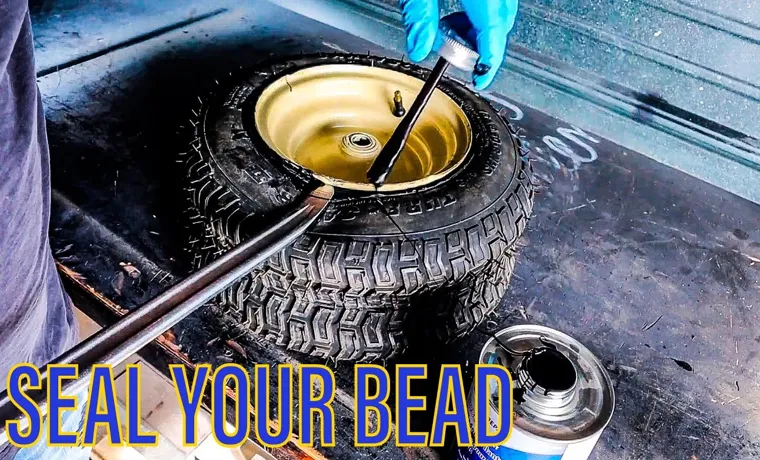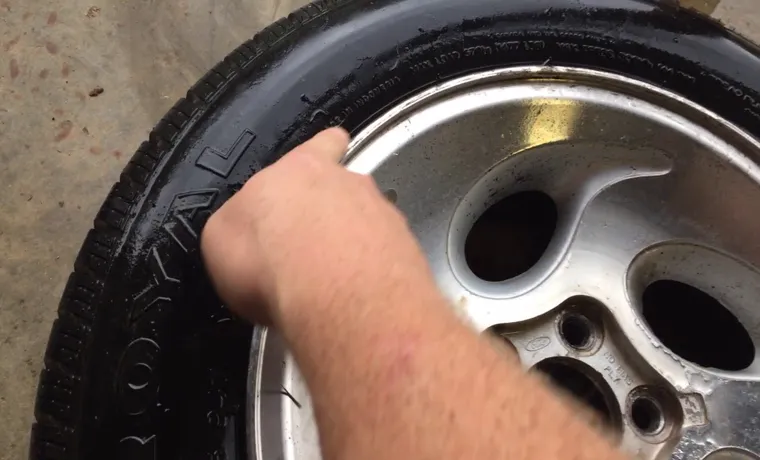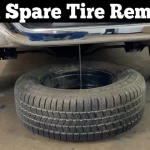Have you ever experienced the frustration of a tire leak around the rim? It can be a major inconvenience, causing your tire to lose pressure quickly, impacting your safety on the road. Not to mention the cost of continuously adding air or replacing the tire altogether. But fear not! There are ways to fix a tire leak around the rim, and it doesn’t have to break the bank.
By using some simple tools and techniques, you can patch up that leak and get back on the road in no time. So, sit back and relax while we take you through the steps to restore your tire to full potential.
Table of Contents
Identify the Source of the Leak
If your tire is leaking around the rim, the first step is to identify the source of the leak. One way to do this is to visually inspect the tire and rim for any punctures, cracks, or corrosion. Another way is to use soapy water and a spray bottle to locate any air bubbles forming around the rim.
This will indicate where the air is escaping and the location of the leak. Once you have identified the source of the leak, you can determine the best method to fix it. This may involve patching the tire, replacing the valve stem, or tightening the wheel lug nuts.
Don’t forget to check the tire pressure regularly and keep an eye out for any signs of damage or wear, as these can lead to future leaks. By taking the time to properly identify and fix a tire leak, you can ensure safer travels on the road.
Inspect the Tire for Debris and Damage
Inspecting your tires regularly is a crucial part of vehicle maintenance. Not only do you want to ensure that the tread is wearing evenly, but you also want to keep an eye out for any debris or damage that could potentially cause a leak. If you discover a tire with low pressure, the first step is to identify the source of the leak.
Look for any punctures, cuts, or nails stuck in the tire’s tread. Small punctures can often be repaired by a professional, but if the damage is severe, you may need to replace the tire. Additionally, make sure to inspect the sidewalls for any bubbles or cracks, as these can also lead to a flat.
Always remember to check the tire’s valve stem for damage and to ensure that the cap is tightly secured. Paying attention to your tires’ condition can help you avoid dangerous blowouts and costly repairs, ultimately keeping you and your passengers safe on the road.

Check the Condition of the Rim
When you notice a flat tire, the first step in fixing the issue is to identify the source of the leak. One common culprit is a damaged rim. Check the condition of the rim by examining it closely for any cracks, dents, or other signs of wear and tear.
If you find any damage, it may be necessary to replace the rim entirely. However, if the rim appears to be in good condition, move on to the tire itself. Look for any obvious punctures or tears, and make sure the valve stem is securely in place.
If you’re still unsure where the leak is coming from, try submerging the tire in water and looking for bubbles – this can help pinpoint the exact location of the leak. No matter where the leak is coming from, be sure to fix it promptly to avoid further damage to your tire and car.
Remove the Tire from the Rim
If you’re dealing with a tire leaking around the rim, it may be necessary to remove the tire from the rim to fix the issue. This can seem daunting, but with the right tools and approach, it’s easier than you might think. Start by deflating the tire completely and removing the valve stem.
Next, use a tire dismounting machine or hand tools, such as tire levers, to carefully pry the tire away from the rim. Take care not to damage the rim or the tire as you work. Once the tire is removed, you can inspect the rim for any damage or debris that may be causing the leak.
Fix any issues you find before reinstalling the tire. With the tire off, it’s also a good time to inspect the inside of the tire for any punctures or damage that may be contributing to the leak. By taking the time to remove the tire and inspect both the rim and the tire, you’ll be able to address any issues causing the leak and ensure a safe and secure ride.
Deflate the Tire
If you need to change a tire, the first step is to deflate it. This might seem counterintuitive, but it actually makes the next steps easier. To do this, you’ll need a valve stem remover, which is a small tool that looks like a screwdriver.
Simply use it to unscrew the valve stem and let the air out. Be sure to do this slowly and carefully, as a burst of air can be dangerous. Once the tire is completely deflated, it’ll be much easier to remove it from the rim.
This might also be a good time to inspect the tire for any damage or wear that might need to be addressed. So don’t skip this important step!
Break the Bead of the Tire
When it comes to changing a tire, one important step is to break the bead of the tire so it can be removed from the rim. Essentially, the bead is the edge of the tire that sits on the rim and creates an airtight seal. If you don’t break the bead, the tire won’t come off, and you won’t be able to change it.
To break the bead, you’ll need a tire iron or a bead breaker tool. Place the tire iron between the tire and the rim, and then pry the tire away from the rim. Make sure to work around the whole tire, breaking the bead on all sides.
Once you’ve broken the bead, you can use the tire iron to lever the tire off the rim. Be careful not to damage the rim while doing this. With the tire removed, you can then go ahead and change it for a new one or repair the old one.
Breaking the bead may seem like a small step, but it’s an essential one in the tire-changing process.
Remove the Tire from the Rim
Removing the tire from the rim can seem like a daunting task, but with the right tools and a bit of know-how, it’s actually quite simple. First, use a tire iron to remove the valve stem and deflate the tire completely. Then, use a tire spoon to pry the edge of the tire away from the rim, working your way around the circumference of the tire.
Be careful not to damage the tire or the rim in the process. Once the tire is completely free from the rim, it can be repaired or replaced as needed. Remember, safety should always come first when working on your vehicle, so make sure you’re wearing protective gloves and eyewear and that your workspace is clean and free of debris.
With a little patience and a steady hand, anyone can remove a tire from a rim like a pro.
Repair the Leak
If you have a tire leaking around the rim, the first step is to locate the source of the leak. Sometimes it can be as simple as a loose valve stem, but it could also be a damaged rim or tire. Once you have identified the issue, the next step is to fix it.
For a loose valve stem, tightening it with pliers or a valve stem tool should do the trick. If the rim is damaged, you may need to take it to a mechanic for repair or replacement. However, if the leak is coming from the tire, you can repair it yourself using a tire patch kit.
Start by deflating the tire, then clean the area around the puncture with the provided rasp tool. Apply the glue from the patch kit and attach the patch. Inflate the tire and check for any additional leaks.
Remember to regularly check your tire pressure to prevent future leaks and ensure your safety on the road.
Clean the Rim and Tire Bead
If you notice air leaking from your tire, it’s essential to take care of the issue as soon as possible. One common cause of a tire leak is debris getting stuck in the rim and tire bead. The rim is the outer part of the wheel, and the tire bead is where the rubber part of the tire meets the metal rim.
To clean this area properly, remove the tire from the rim and inspect for any visible debris or damage. A soft-bristled brush can then be utilized to eliminate any dirt or debris. Next, use a mild detergent and water to clean the tire bead and rim, ensuring that all cleaning agents are thoroughly rinsed off before reattaching the tire.
It is critical to recheck the tire after some time to ensure that the issue has been entirely fixed. By taking proper care of your tires, you can ensure a safe and comfortable ride.
Apply the Patch or Sealant
If you’ve identified a leak in your home, the next step is to apply a patch or sealant to repair it. The type of patch or sealant you use will depend on the location and size of the leak, as well as the material that needs to be repaired. For example, a small leak in a plastic pipe could be repaired with a plumbing epoxy, while a larger leak in a metal pipe might need a rubber or silicone-based sealant.
Make sure to follow the instructions carefully when applying the patch or sealant, as some may require a certain temperature or drying time to properly set. Once the patch or sealant is in place, monitor the area closely to ensure the leak has been fully repaired. Remember, the longer you wait to repair a leak, the more damage it can potentially cause.
Don’t hesitate to seek the help of a professional if you’re unsure about the best way to repair the leak.
Reinstall the Tire on the Rim
When it comes to repairing a tire leak, it’s important to ensure that the tire is properly reinstalled on the rim. This process may seem daunting, but with the right tools and a bit of patience, it can be a straightforward task. Start by cleaning the rim and tire bead thoroughly to ensure that there is no dirt, debris or moisture between them.
Next, lubricate the bead with a specialized tire lubricant, which makes it easier to slide the tire onto the rim. Place the tire onto the rim, ensuring that the valve stem is in the correct position and that the tire is straight. Finally, use a tire iron and a bit of elbow grease to work the tire bead over the rim edge.
Check that the tire is seated correctly on the rim and inflate it to the proper pressure. By following these steps, you can rest assured that your tire will stay leak-free and keep you rolling safely down the road.
Test for Proper Inflation and Balance
If you’re experiencing a tire leaking around the rim, there are a few things you can do to fix the issue. Firstly, ensure that your tire is properly inflated and balanced. If a tire is underinflated or imbalanced, it can cause it to leak around the rim.
To fix it, use a tire pressure gauge and check that it has the correct amount of air. You should also check the balance with a tire balancer or go to a mechanic to have them check it for you. If you’re still experiencing a leak after checking the tire’s inflation and balance, it could be due to a defective rim or tire.
In this case, it’s best to replace the rim or tire entirely to prevent any further issues. Remember, always stay safe and have a professional look at your car if you have any doubts or concerns.
Inflate the Tire to the Recommended Pressure
Proper tire inflation is essential for ensuring a smooth and safe ride. One way to test this is through a simple check of your tire pressure with a gauge. Make sure to test each tire individually, as they may vary in pressure.
Once you have your readings, compare them to the recommended pressure listed in your vehicle’s owner’s manual or on the tire itself. If your tire is underinflated, it can affect your fuel efficiency, handling, and even cause a blowout. On the other hand, overinflated tires can have less contact with the road, leading to poor traction and longer stopping distances.
Properly inflating your tires not only improves your vehicle’s performance but also extends their lifespan, saving you money in the long run. So, the next time you hit the road, take a few minutes to check your tire pressure and inflate them to the recommended level. Your safety and pocketbook will thank you.
Check the Tire for Proper Balance
If you want to ensure a smooth and safe driving experience, it’s crucial to test your car’s tires for proper inflation and balance. This includes visually inspecting the tire for any damage or wear and tear and making sure that it’s inflated to the recommended PSI. However, it’s also important to check the tire’s balance.
An unbalanced tire can cause vibrations, uneven wear, and even lead to a blowout. To check for tire balance, head to your local mechanic or auto repair shop. They’ll use specialized equipment to spin the tire and check for any imbalances.
If an imbalance is detected, they’ll add weights to the wheel to bring it back into balance. It’s a quick and simple process that can greatly improve the handling and longevity of your tires. So, next time you’re getting your car serviced, make sure to ask your mechanic to check your tires for proper balance.
Trust me, your car (and your safety) will thank you!
Prevent Future Leaks
If you’re experiencing tire leaks around the rim, there are some easy steps you can take to prevent them in the future. Firstly, make sure that the rim is clean and free of any rust or debris that might cause a seal to break. Use a wire brush or sandpaper to clean any buildup before making any repairs.
Secondly, check the tire pressure regularly to ensure that it’s at the level recommended by the manufacturer, as low pressure can cause air to leak from around the rim. Lastly, consider investing in some tire sealant, which can help prevent leaks and fill any small holes or cracks that might cause air to escape. By following these simple steps, you can ensure that your tires and rims stay in good condition for longer, preventing future leaks and keeping you safe on the road.
So, next time you’re dealing with a pesky tire leak, keep these tips in mind and take action to prevent it from happening again in the future!
Maintain Proper Tire Pressure
Maintaining proper tire pressure is an essential aspect of preventing future leaks. When your tires are inflated at the recommended pressure level, it reduces the risk of punctures and damages. A deflated tire can easily get damaged when driving over a sharp object, causing a leak that might end up costing you extra money to fix.
However, over-inflated tires are equally problematic, leading to uneven pressure distribution and potential tire blowouts. Monitoring your tire pressure regularly and adjusting it accordingly will save you money, time, and from the risk of getting stuck on the road with a flat tire. Remember, a well-inflated tire provides a better grip on the road, and it can ensure your car’s stability and safety.
So, always keep a tire gauge in your vehicle to check for the right inflation and avoid future leaks.
Avoid Overloading the Vehicle
One important way to prevent future leaks in your vehicle is to avoid overloading it. While it may be tempting to pack everything and the kitchen sink for a long road trip, putting too much stress on your vehicle can cause damage and wear and tear on your tires and suspension. When you overload your car, it puts pressure on the seals and gaskets, making it easier for leaks to occur.
To avoid this problem, make sure to pack only what is necessary and keep your vehicle’s weight within its recommended limit. By doing this, you can prevent the need for costly repairs and keep your car leak-free for longer. Remember, a little bit of planning and organization can go a long way in protecting your vehicle from leaks and other damage.
Replace Worn Tires
If you’re experiencing frequent tire leaks, it may be time to replace your worn tires. This is especially important if you frequently drive on rough terrain or harsh weather conditions. As tires age, their rubber becomes less supple and more prone to cracks, punctures, and leaks.
By investing in a new set of tires, you can prevent future leaks and keep your vehicle operating safely and efficiently. Plus, modern tires are designed with advanced technologies that improve their traction, handling, and durability. So not only will you reduce the risk of leaks, but you’ll also enjoy a more comfortable and reliable ride.
Don’t wait for a tire blowout or flat to replace your worn tires—be proactive and prioritize your safety on the road.
Conclusion
In the words of Benjamin Franklin, ‘An ounce of prevention is worth a pound of cure.’ The best way to fix a tire leaking around the rim is to make sure it never happens in the first place. Regularly checking tire pressure and inspecting the rims for any damage can save you from the headache of a leaky tire.
But if the damage is already done, fear not! With a little elbow grease and some handy tools, fixing a tire leaking around the rim is a breeze. Just remember to take your time, stay safe, and always have a spare tire on hand. After all, nothing puts a damper on a road trip like a flat tire!”
FAQs
What causes a tire to leak around the rim?
A tire can leak around the rim due to a damaged valve stem, corroded rim, or improper installation of the tire.
How can I locate the source of the tire leak around the rim?
Before attempting to fix the leak, you must find out where the air is escaping. You can do this by immersing the tire in water and looking for bubbles.
Can I fix a tire leaking around the rim with sealant?
Yes, you can use a tire sealant for small leaks around the rim. But keep in mind, this is a temporary fix, and the tire should be properly repaired as soon as possible.
Do I need to replace the tire if it is leaking around the rim?
Not necessarily. If the tire is still in good condition and the leak is small, it can be fixed. However, if the tire is severely damaged, it may need to be replaced.
What is the cost of fixing a tire leaking around the rim?
The cost of fixing a tire leak around the rim depends on the cause and severity of the leak. It can range from a few dollars for a simple repair to hundreds of dollars for a new tire.
Can I prevent a tire from leaking around the rim?
Yes, you can prevent a tire from leaking around the rim by regularly inspecting and maintaining the tire and replacing it when it is worn out.
How long does it take to fix a tire leaking around the rim?
The time it takes to fix a tire leaking around the rim depends on the cause and severity of the leak. It can take anywhere from a few minutes to a few hours to fix the problem.



